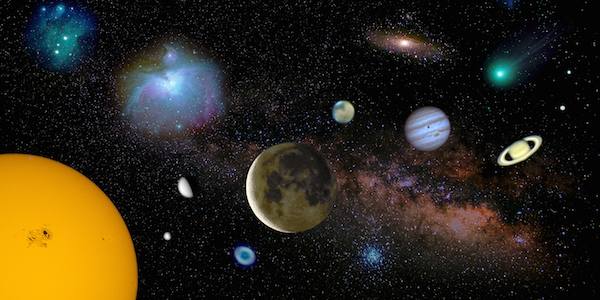
[Image above] Credit: Rob Pettengill; Flickr CC BY-NC-ND 2.0
While it took Deep Thought 7.5 million years to calculate the answer to the ultimate question of life, the universe, and everything, it could take us humans much less time to answer how it all began.
And thanks to new research, our answer will probably be much more informative than Deep Thought’s.
Our Solar System—home to Mercury, Venus, Earth, Mars, Jupiter, Saturn, Uranus, and Neptune (sorry, Pluto)—is somewhere in the neighborhood of 4.6 billion years old. But even way back then, how did these large bodies form from the bits of rock and dust swirling around in space?
Scientists at Fraunhofer Institute for Silicate Research (Würzburg, Germany), collaborating with scientists at Westphalian Wilhelms University of Münster and the Technical University of Braunschweig in Germany, are experimenting with glass to help answer that very question of how it all began.
That question begins with understanding chondrules, small space-born balls of glass and minerals. Chondrules vary in composition—including olivine, pyroxene, and glass—and size, measuring ~0.1 μm to several mm in diameter. They also happen to be rather beautiful, especially under cross-polarized light. See for yourself here (scroll down).
Beyond beauty, chondrules are critical to the beginning because they can aggregate together into larger clumps, called chondrites (aka, meteorites). Those chondrites can accrete together to form larger stuff, like asteroids and planets. As the bodies get bigger, aggregated mass and energy acts on the founding components, adding critical stuff-changing elements of pressure and heat. Before you know it, a planet is born. (I hope there are no planetologists reading, because that’s an incredibly simplified version of events.)
So understanding chondrules themselves and how they merge together is critical knowledge to understand what happened when our planets formed those 4.6 million years ago.
To that end, scientists at Fraunhofer ISC have created glass beads that mimic the composition of chondrules as part of a larger experimental effort to understand how chrondrules merge together.
“This glass is very different from the material composition of technical glasses with which we are usually working,” Martin Kilo, head of the ISC Glass Unit, says in a Fraunhofer press release. “That’s why we have used modeling programs in advance to calculate which melting conditions prevail for the required compositions, how stable the glass particles are, as well as the temperatures and forms at which they crystallize.”
After getting the composition right, the scientists used two different methods to form rounded glass beads. Thermal treatment of glass gravel to round the edges, or—akin to how marbles are produced—mechanical grinding of glass cubes.
The scientists tried out various glass compositions, melting each under controlled temperature and atmosphere to see if it matched theoretical models of chondrule glass composition.

The view from above in the furnace interior shows the glass beads that are produced by Fraunhofer ISC. Credit: Fraunhofer ISC
The scientists then dropped the beads in a 146-m tall drop tower at the Center for Applied Space Technology and Microgravity in Bremen.
According to the release, “The drop tower which is operated there surrounds a 120-meter-high steel drop tube, in which a high-vacuum is kept. Through a catapult system, the glass beads are shot in a capsule to the tip of the drop tube. As a result, approximately 9.5 seconds of weightlessness are achieved—the same conditions as in space. During this period, the glass beads are heated up to 1,100°C.”
Beads collide during the drop, conglomerating into larger aggregates. “Our colleagues from Münster then investigate how the beads merge, whether the clusters are composed of a homogeneous composition or whether the form of the individual beads is still recognizable, and whether and to what extent crystallization results,” Kilo says in the release.
The scientists will next compare the experimental results with meteorite observations to see if the models hold up. Ultimately, they might be able to develop an accurate model of what happened 4.6 million years ago.
And in case you were wondering about Deep Thought’s answer to the ultimate question of life, the universe, and everything—it’s 42.
Author
April Gocha
CTT Categories
- Aeronautics & Space
- Basic Science
- Glass
- Material Innovations
- Modeling & Simulation


